Investigating the Mesh Size Selectivity of Olive Flounder (Paralichthys olivaceus) Gillnets for Fisheries Resource Management in the East Sea
Abstract
1. Introduction
2. Materials and Methods
2.1. Marine Fishing Experiment
2.1.1. Experimental Gear
2.1.2. Experimental Methods
2.2. Estimation of Mature Body Length
2.3. Estimation of the Mesh Selectivity Curve
3. Results
3.1. Results of Marine Fishing Experiment
3.2. Mature Body Length
3.3. Mesh Size Selectivity
4. Discussion
5. Conclusions
- The mesh size used in the olive flounder gillnet fishery along the eastern coast of Korea varies depending on the fishing season, ranging from 90 to 150 mm. The most commonly used mesh sizes are 90 and 135 mm. The preferred gear type is the support-line gillnet, which allows fewer individuals to escape during lifting.
- Analysis of the maturity ratio of females caught from May to September, estimated to be the spawning period, revealed that the mature body length (TL) of female olive flounder inhabiting the eastern coastal area was 43.0 cm (50%), 51.8 cm (75%), and 72.2 cm (97.5%).
- Mesh selectivity of the gillnet was analyzed using the body length distribution of olive flounder according to mesh size. The total length range of olive flounder increased with an increase in mesh size. The bi-normal function exhibited the best fit for estimating the mesh selectivity curve within the SELECT model. The optimal mesh size was determined by calculating the mesh sizes at which 25%, 50%, and 75% of olive flounders are selected based on the value from each mesh selectivity curve (i.e., females’ mature length) and the minimum landing size (35 cm). The mature body length ranged 133.5–148.8 mm, and the range of the value for the appropriate mesh size, estimated based on the minimum landing size (35 cm), was 108.7–121.1 mm. In the analysis and comparison, the range of values based on the mature body length was 133.5–148.8 mm, and that based on the minimum landing size was 108.7–121.1 mm. The optimal mesh size derived from the bi-normal function curve based on the mature body length was estimated at 140.1 mm, whereas that estimated based on the minimum landing size was 114.0 mm.
Author Contributions
Funding
Institutional Review Board Statement
Data Availability Statement
Conflicts of Interest
References
- Kim, I.S.; Choi, Y.; Lee, C.L.; Lee, Y.J.; Kim Lim, J.H. Illustrated Book of Korean Fish; Kyo-Hak Publishing: Seoul, Republic of Korea, 2005; pp. 1–615. [Google Scholar]
- Kim, S.H.; Lim, J.H.; Lee, K.H.; Park, S.W. Effect of twine thickness on size-selectivity of drift net for the yellow croaker Larimichthys polyactis in southwestern Sea of Korea. CJOL 2016, 34, 1199–1208. [Google Scholar] [CrossRef]
- Holst, R.; Wileman, D.; Madsen, N. The effect of twine thickness on the size selectivity and fishing power of Baltic cod gill nets. Fish. Res. 2002, 56, 303–312. [Google Scholar] [CrossRef]
- Wakayama, K.; Fujimori, Y.; Itaya, K.; Murakami, O.; Miura, T. Mesh selectivity of gillnet for point head flounder Cleisthenes pinetorum. Nippon. Suisan Gakkaishi 2006, 72, 174–181. [Google Scholar] [CrossRef][Green Version]
- Yano, A.; Tokai, T.; Kawabata, A. Selectivity of experimental drift net for chub mackerel Scomber japonicus. Nippon. Suisan Gakkaishi 2012, 78, 681–691. [Google Scholar] [CrossRef]
- Park, C.D.; An, H.C.; Cho, S.K.; Baik, C.I. Size selectivity of gill net for male snow crab, Chionoecetes opilio. J. Kor Soc. Fish. Technol. 2003, 39, 143–151. [Google Scholar] [CrossRef][Green Version]
- Park, C.D.; An, H.C.; Cho, S.K.; Bae, B.S.; Park, H.H.; Bae, J.H.; Kim, H.Y. Size selectivity of gill net for female snow crab, Chionoecetes opilio. J. Kor Soc. Fish. Tech. 2009, 45, 122–127. [Google Scholar] [CrossRef]
- Chang, Y.H.; Cho, B.K.; Park, J.S.; Lee, W.L. Mesh selectivity of gill nets for silver pomfret, Pampus argenteus. Bull. Kor. Soc. Fish. Tech. 2007, 43, 169–175. [Google Scholar] [CrossRef]
- Cho, Y.B.; Park, C.D.; Lee, J.H. A study on the selectivity of the mesh size in trammel net for Cynoglossidae spp. Bull. Kor. Soc. Fish. Tech. 2000, 36, 89–95. [Google Scholar]
- Kim, S.H.; Lee, J.H. Mesh selectivity in trammel net for flatfish. Bull. Kor. Soc. Fish. Technol. 2002, 38, 91–100. [Google Scholar]
- NIFS (National Institute of Fisheries Science). Ecology and Fishing Ground of Fisheries Resources in Korean Waters; NIFS: Busan, Korea, 2017; p. 409.
- Fujimori, Y.; Tokai, T. Estimation of gillnet selectivity curve by maximum likelihood method. Fish. Sci. 2001, 67, 644–654. [Google Scholar] [CrossRef]
- Akiyama, S.; Kaihara, S.; Arimoto, T.; Tokai, T. Size selectivity of a trammel net for oval squid Sepioteuthis lessoniana. Fish. Sci. 2004, 70, 945–951. [Google Scholar] [CrossRef]
- Park, C.D.; Jeong, E.C.; Shin, J.K.; An, H.C.; Fujimori, Y. Mesh selectivity of encircling gill net for gizzard shad Konosirus punctatus in the coastal sea of Korea. Fish. Sci. 2004, 70, 553–560. [Google Scholar] [CrossRef]
- Akaike, H. A new look at the statistical model identification. IEEE Trans. Autom. Control 1974, 19, 716–723. [Google Scholar] [CrossRef]
- Harada, M.; Tokai, T.; Kimura, M.; Hu, F.; Shimizu, K. Size selectivity of escape holes in conger tube traps for inshore hagfish Eptatretus burgeri and white-spotted conger Conger myriaster in Tokyo bay. Fish. Sci. 2007, 73, 477–488. [Google Scholar] [CrossRef]
- Hamley, J.M. Review of gillnet selectivity. J. Fish. Board. Can. 1975, 32, 1943–1969. [Google Scholar] [CrossRef]
- Hovgård, H. A two-step approach to estimating selectivity and fishing power of research gill nets used in Greenland waters. Can. J. Fish. Aquat. Sci. 1996, 53, 1007–1013. [Google Scholar] [CrossRef]
- Baranov, F.I. The capture of fish by gillnets. Mater. Poznoniyu Russ. Rybolov. 1914, 3, 56–99. [Google Scholar]
- Millar, R.B.; Fryer, R.J. Estimating the size-selection curves of towed gears, traps, nets and hooks. Rev. Fish. Biol. Fish. 1999, 9, 89–116. [Google Scholar] [CrossRef]
- Millar, R.B.; Walsh, S.J. Analysis of trawl selectivity studies with an application to trouser trawls. Fish. Res. 1992, 13, 205–220. [Google Scholar] [CrossRef]
- Losanes, L.P.; Matuda, K.; Fujimori, Y. Estimating the entangling effect of trammel and semi-trammel net selectivity on rainbow trout (Oncorhynchus mykiss). Fish. Res. 1992, 15, 229–242. [Google Scholar] [CrossRef]
- Yokoyama, S.; Nishiuchi, S.; Maruyama, S. Mesh selectivity of flatfish gillnet for cresthead flounder, Pleuronectes schrenki. Nippon. Suisan Gakkaishi 1998, 64, 979–986. [Google Scholar] [CrossRef][Green Version]
- Kitahara, T. On sweeping trammel net (Kogisasiami) fishery along coast of the San in district III. Mesh selectivity curve of sweeping trammel net for Branquillos. Bull. Jap. Soc. Sci. Fish. 1968, 34, 759–763. [Google Scholar]
- Matsushita, Y.; Inoue, Y. Variation of square mesh cod end selectivity for Walleye Pollock (Theragra chalcogramma) with respect to difference in body shape. Nippon. Suisan Gakkaishi 1997, 63, 23–29. [Google Scholar] [CrossRef]
- Park, C.D.; Bae, J.H.; Cho, S.K.; An, H.C.; Kim, I.O. Size selectivity of the gill net for spinyhead sculpin, Dasycottus setiger in the eastern coastal waters of Korea. J. Korean Soc. Fish. Technol. 2016, 52, 281–289. [Google Scholar] [CrossRef]
- Sato, M.; Tokai, T.; Kawabata, A. Mesh selectivity of experimental drift net for Japanese sardine. Nippon. Suisan Gakkaishi 2015, 81, 290–292. [Google Scholar] [CrossRef][Green Version]
- Sato, M.; Tokai, T.; Mori, Y.; Nakame, Y. Appropriate mesh size combinitation of research drift net for chub mackerel resources off Hokkaido, Pacific. Nippon. Suisan Gakkaishi 2016, 82, 290–297. [Google Scholar] [CrossRef]
- Erzini, K.; Goncalves, J.M.S.; Bentes, L.; Moutopoulos, D.K.; Casal, J.A.H.; Soriguer, M.C.; Puente, E.; Errazkin, L.A.; Stergiou, K. Size selectivity of trammel nets in southern European small-scale fisheries. Fish. Res. 2006, 79, 183–201. [Google Scholar] [CrossRef]
- Kim, S.H.; Park, S.W.; Lee, K.H.; Yang, Y.S. The estimation of the optimum mesh size selectivity of a drift net for yellow croaker (Larimichthys polyactis) using by the SELECT model. J. Kor Soc. Fish. Technol. 2012, 48, 10–19. [Google Scholar] [CrossRef]
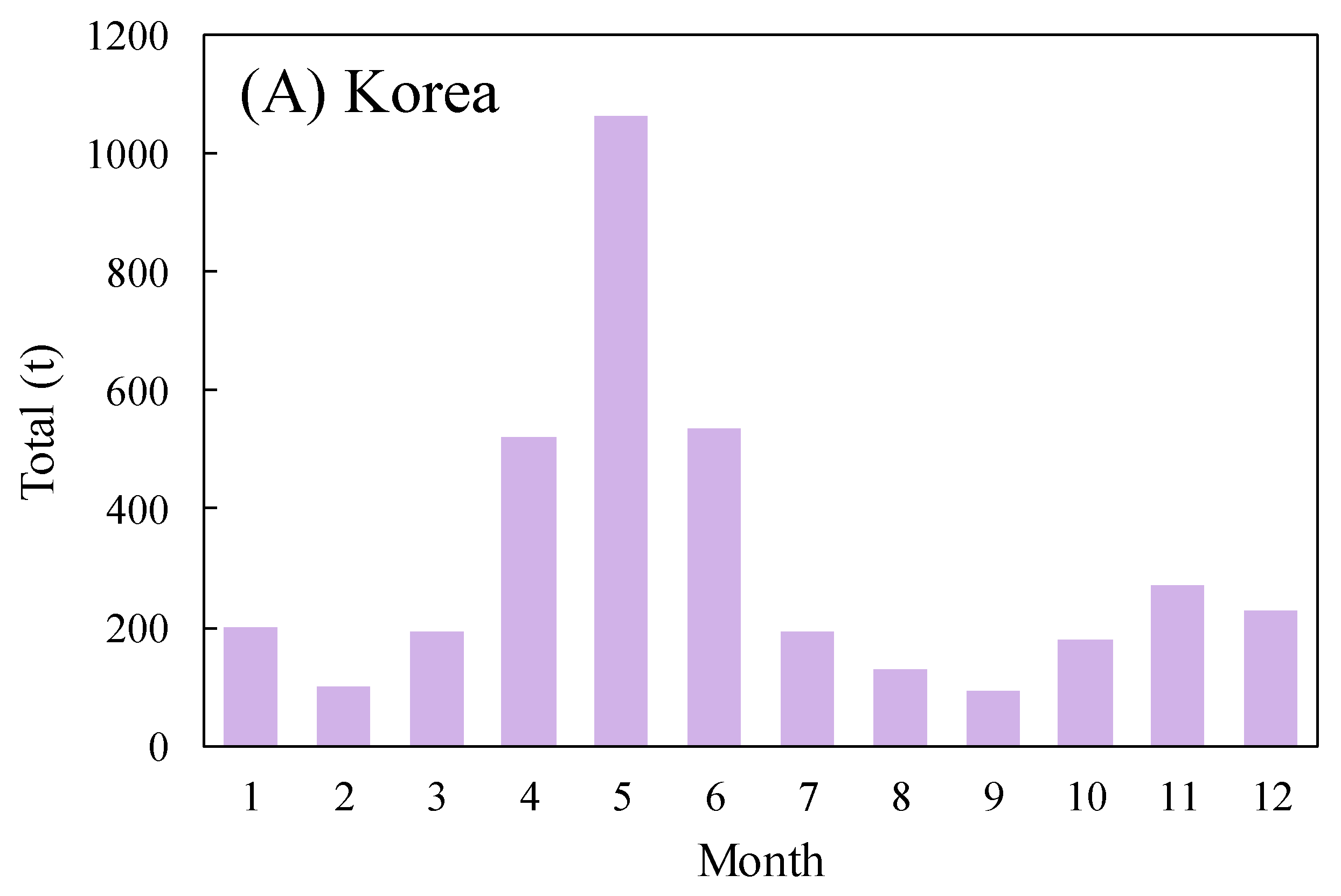
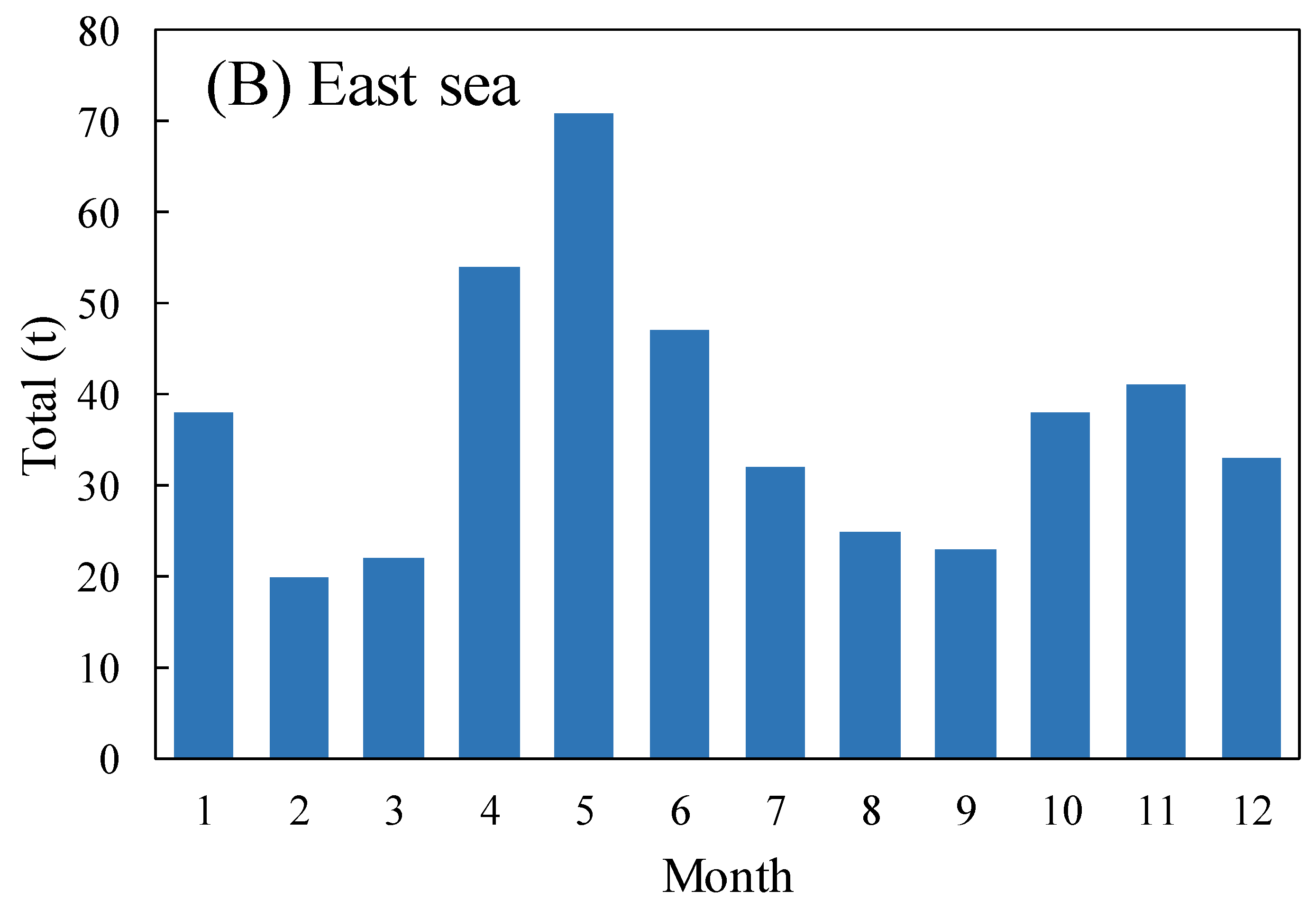
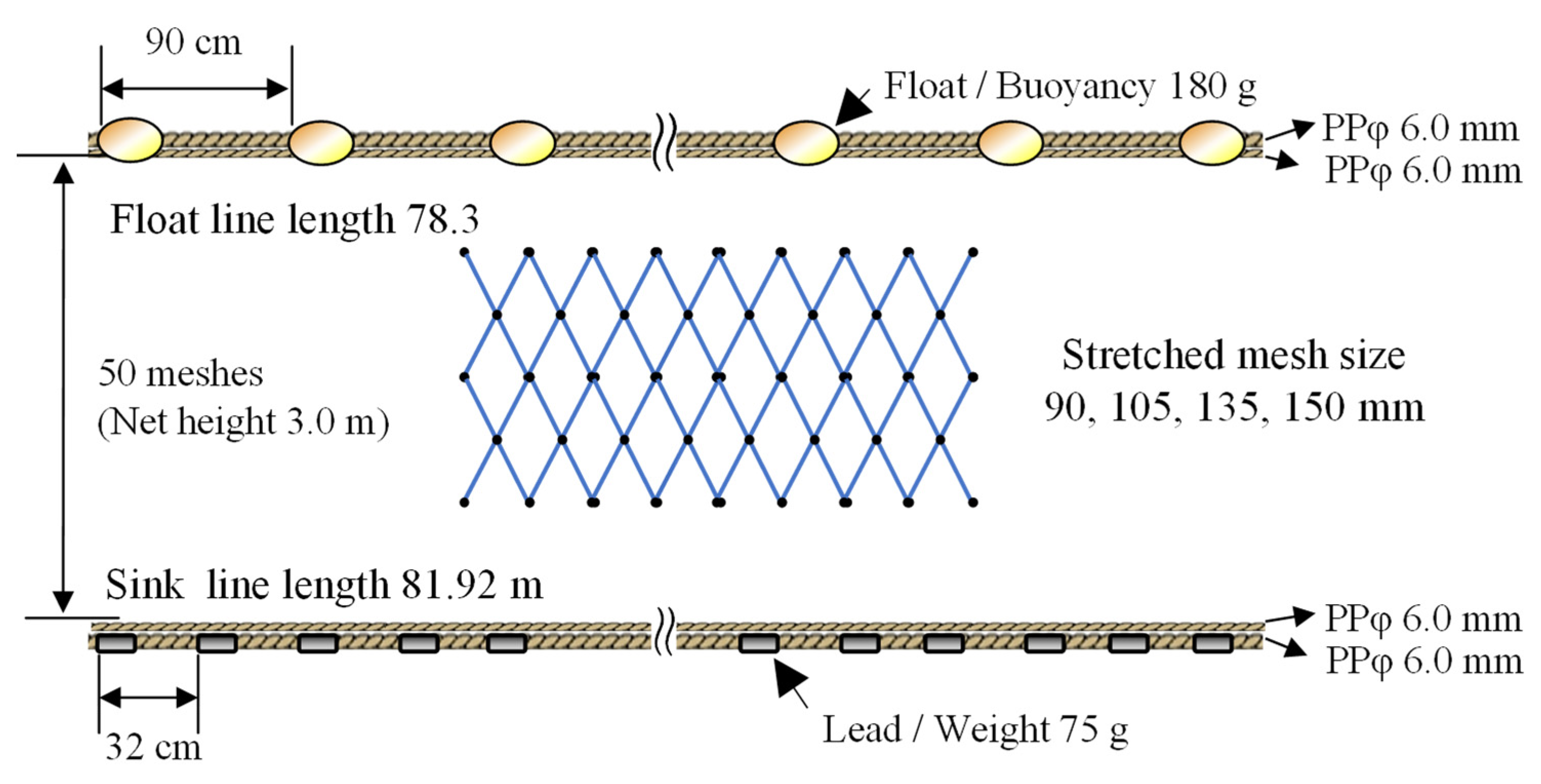
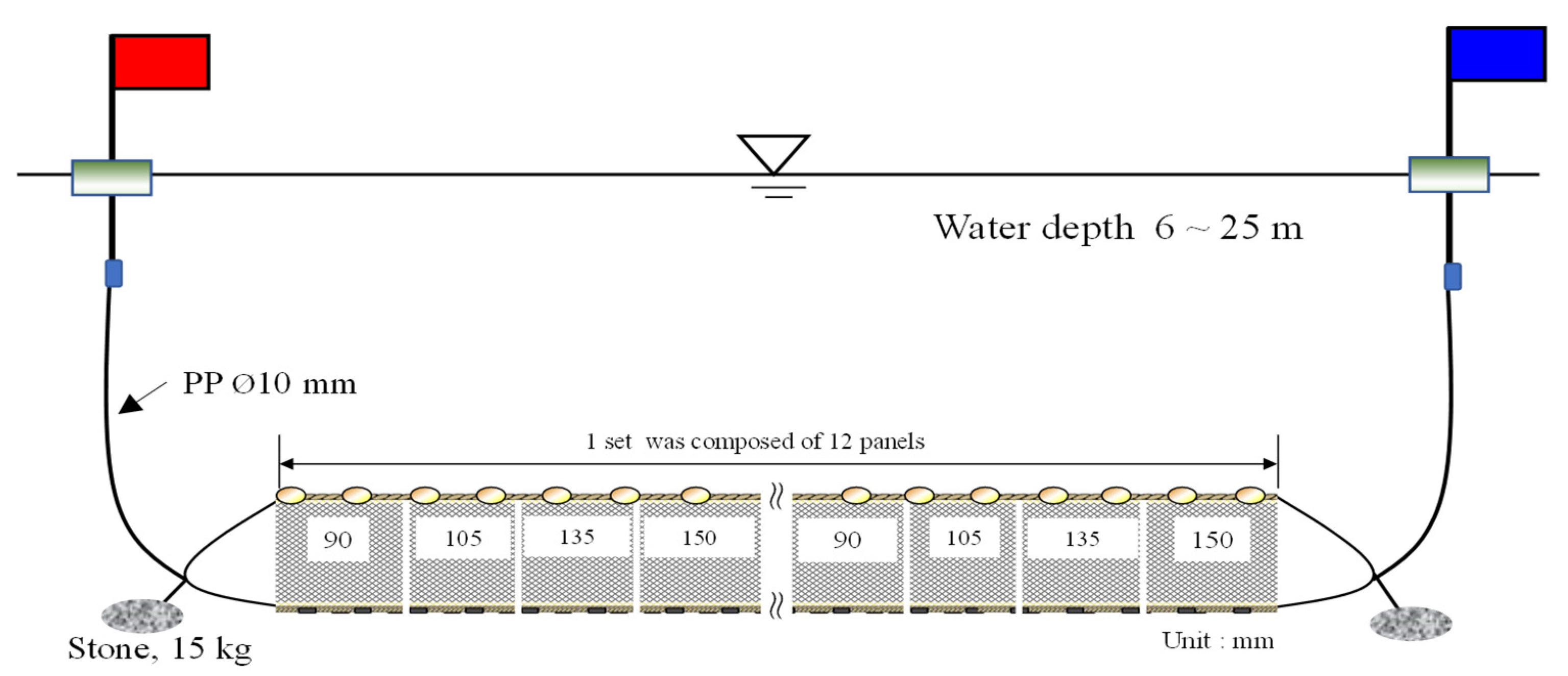
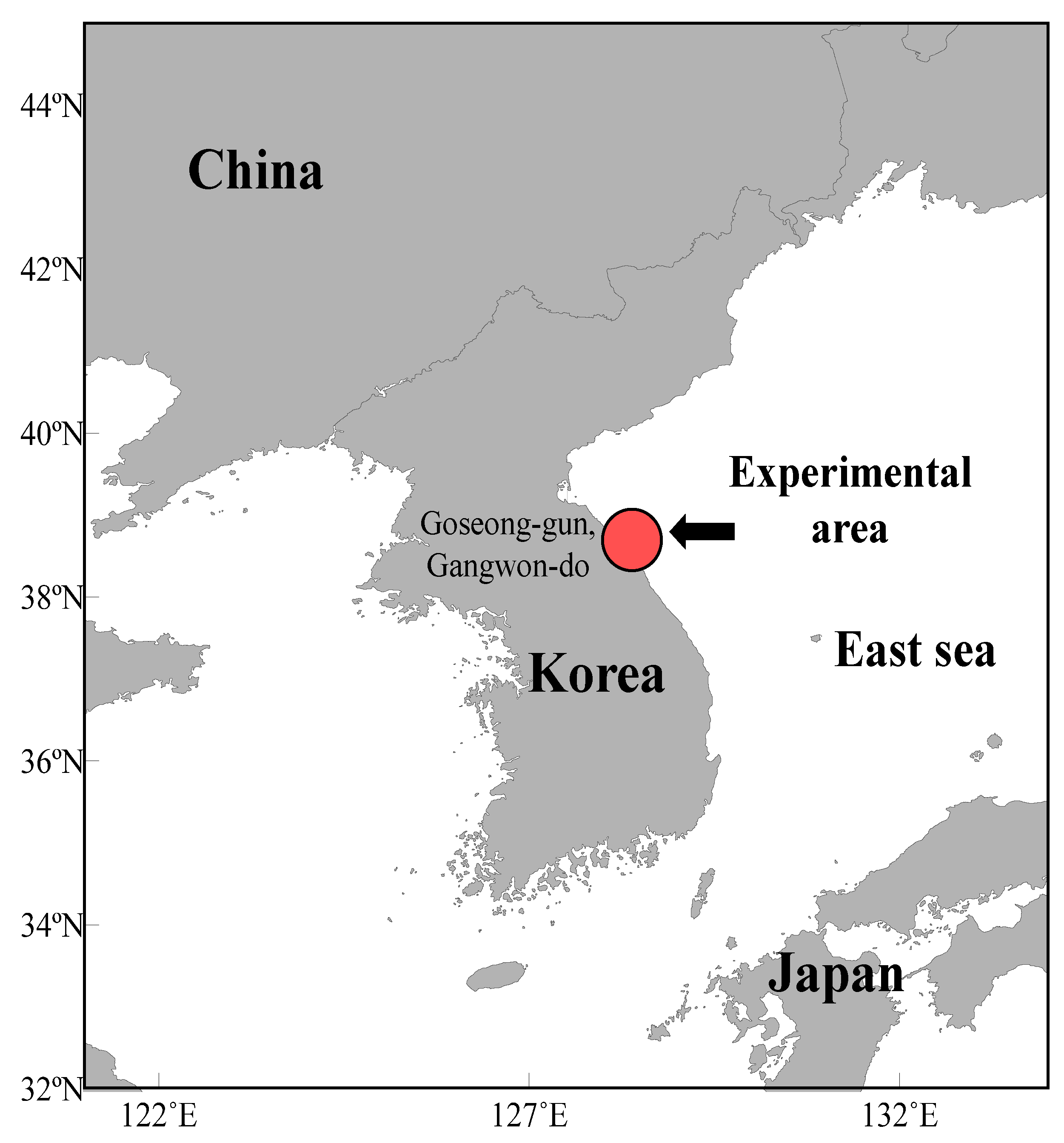

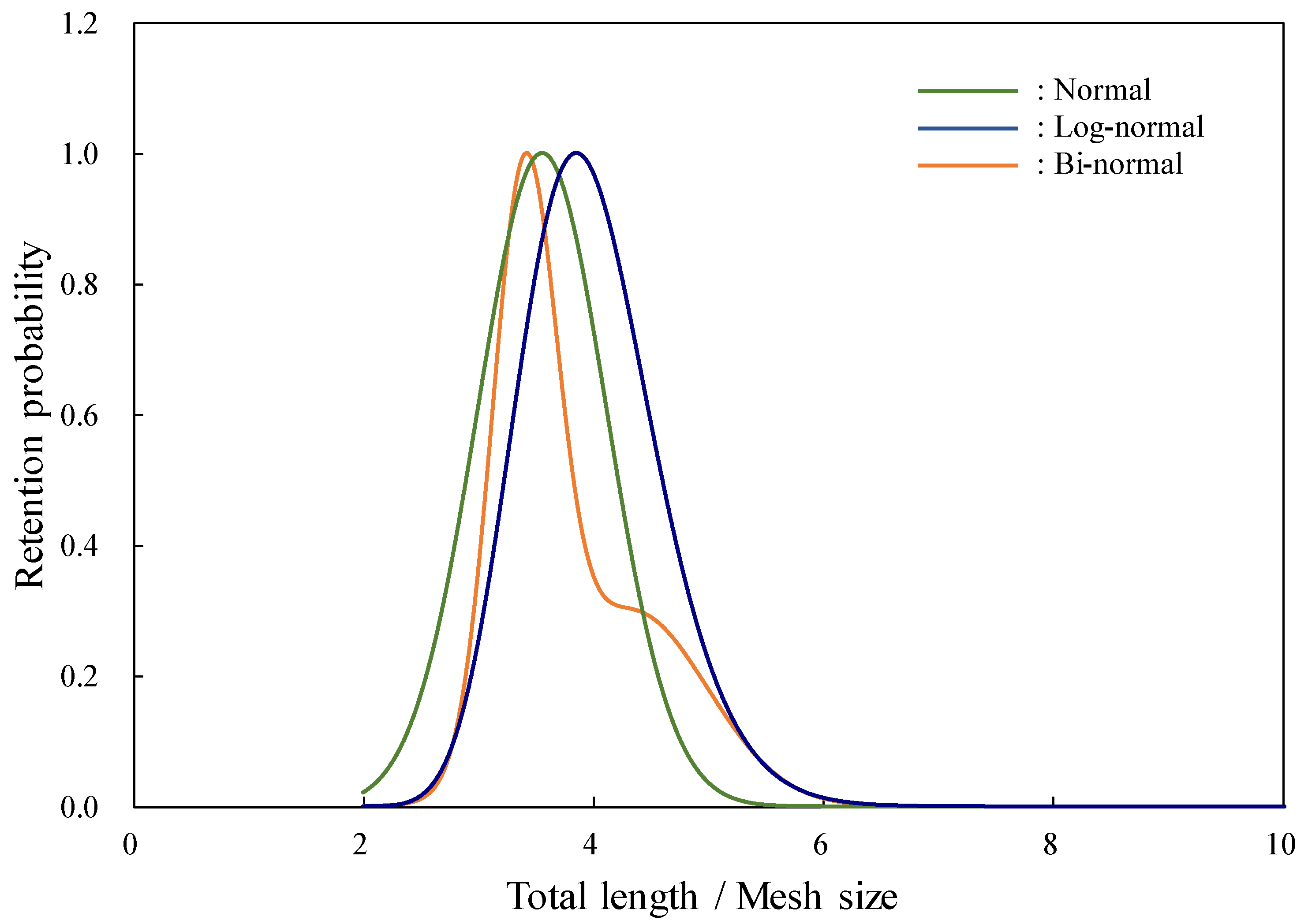
| Mesh Size (mm) | Minimum Size (mm) | Maximum Size (mm) | Mean Size (mm) | Length of Float Line (m) | Length of Sink Line (m) |
|---|---|---|---|---|---|
| 90 | 86.4 | 100.5 | 96.6 | 78.3 | 93.5 |
| 105 | 100.4 | 105.5 | 102.7 | ||
| 135 | 126.8 | 134.0 | 139.2 | ||
| 150 | 143.9 | 152.3 | 148.8 |
| Common Name | Scientific Name | Catch in Number | Catch in Weight | CPUE (1) (g/net) | ||
|---|---|---|---|---|---|---|
| Individual | Ratio (%) | (g) | Ratio (%) | |||
| Fishes | ||||||
| Olive flounder | Paralichthys olivaceus | 182 | 33.09 | 167,009 | 47.87 | 526.7 |
| Bluefin sea robin | Chelidonichthys spinosus | 118 | 21.45 | 44,900 | 12.87 | 143.9 |
| Stone flounder | Kareius bicoloratus | 53 | 9.64 | 37,872 | 10.86 | 121.4 |
| Brown sole | Pseudopleuronectes herzensteini | 46 | 8.36 | 23,000 | 6.59 | 73.7 |
| Greenling | Hexagrammos otakii | 27 | 4.91 | 16,715 | 4.79 | 53.6 |
| Chub mackerel | Scomber japonicas | 14 | 2.55 | 1904 | 0.55 | 6.1 |
| Round nose flounder | Eopsetta grigorjewi | 12 | 2.18 | 2145 | 0.61 | 6.9 |
| Marbled sole | Pleuronectes yokohamae | 11 | 2.00 | 12,545 | 3.60 | 40.2 |
| Shaggy sea raven | Hemitripterus villosus | 11 | 2.00 | 2269 | 0.65 | 7.3 |
| Yellow tail | Seriola quinqueradiata | 9 | 1.64 | 7768 | 2.23 | 24.9 |
| Arabesque greenling | Pleurogrammus azonus | 7 | 1.27 | 3518 | 1.01 | 11.3 |
| Jacopever | Sebastes schlegelii | 6 | 1.09 | 2840 | 0.81 | 9.1 |
| Rough scale sole | Clidoderma asperrimum | 4 | 0.73 | 783 | 0.22 | 2.5 |
| Black progy | Acanthopagrus schlegelii | 3 | 0.55 | 3008 | 0.86 | 9.6 |
| Pacific cod | Gadus macrocephalus | 3 | 0.55 | 2292 | 0.66 | 7.3 |
| Elknorn sculpin | Alcichthys elongates | 3 | 0.55 | 385 | 0.11 | 1.2 |
| Crest head flounder | Pseudopleuronectes schrenki | 3 | 0.55 | 764 | 0.22 | 2.5 |
| Yellow goosefish | Lophius litulon | 3 | 0.55 | 4837 | 1.39 | 15.5 |
| Whip sculpin | Gymnocanthus intermedius | 2 | 0.36 | 378 | 0.11 | 1.2 |
| Goggle eye | Cookeolus japonicas | 2 | 0.36 | 590 | 0.17 | 1.9 |
| Elf sculpin | Enophrys diceraus | 2 | 0.36 | 220 | 0.06 | 0.7 |
| NEI (2) | 18 | 3.09 | 11,087 | 3.18 | 35.5 | |
| Crustaceans | ||||||
| Sand crab | Ovalipes punctatus | 3 | 0.55 | 611 | 0.18 | 2.0 |
| Swimming crab | Portunus trituberculatus | 2 | 0.36 | 560 | 0.16 | 1.8 |
| Portunidae sp. | Trituberculatus sp. | 1 | 0.18 | 318 | 0.09 | 1.0 |
| Japanese swimming crab | Charybdis japonica | 1 | 0.18 | 160 | 0.05 | 0.5 |
| Gastropods | ||||||
| Conch sp. | Buccinidae sp. | 2 | 0.36 | 137 | 0.04 | 0.4 |
| Sea cucumber | Stichopus japonicas | 1 | 0.18 | 141 | 0.04 | 0.5 |
| Cephalopods | ||||||
| Webfoot octopus | Amphioctopus fangsiao | 1 | 0.18 | 99 | 0.03 | 0.3 |
| Total | 550 | 100 | 348,851 | 100 | ||
| Model | Parameter | |||||||||||
|---|---|---|---|---|---|---|---|---|---|---|---|---|
| Normal | 3.555 | 0.561 | 0.300 | 0.332 | 0.255 | 0.114 | 0.025 | 0.604 | ||||
| Log-normal | 3.852 | 0.151 | 0.065 | 0.175 | 0.429 | 0.331 | 0.025 | 0.604 | ||||
| Bi-normal | 3.400 | 0.281 | 0.657 | 0.336 | 1.124 | 0.129 | 0.326 | 0.319 | 0.226 | |||
| (1) | (2) | (3) | (4) | |||||||||
| Normal | −104.9 | 71.5 | 36.0 | 231.8 | ||||||||
| Log-normal | −100.8 | 59.4 | 36.0 | 223.6 | ||||||||
| Bi-normal | −96.3 | 42.7 | 36.0 | 214.5 | ||||||||
| Model | (1) | (2) | ||
|---|---|---|---|---|
| Normal | 164.1 | 148.8 | 137.4 | 26.7 |
| Log-normal | 143.8 | 133.5 | 125.4 | 18.4 |
| Bi-normal | 146.8 | 140.1 | 134.4 | 12.4 |
| Model | (1) | (2) | ||
|---|---|---|---|---|
| Normal | 133.6 | 121.1 | 111.8 | 21.8 |
| Log-normal | 117.1 | 108.7 | 102.0 | 15.0 |
| Bi-normal | 119.5 | 114.0 | 109.4 | 10.1 |
Disclaimer/Publisher’s Note: The statements, opinions and data contained in all publications are solely those of the individual author(s) and contributor(s) and not of MDPI and/or the editor(s). MDPI and/or the editor(s) disclaim responsibility for any injury to people or property resulting from any ideas, methods, instructions or products referred to in the content. |
© 2023 by the authors. Licensee MDPI, Basel, Switzerland. This article is an open access article distributed under the terms and conditions of the Creative Commons Attribution (CC BY) license (https://creativecommons.org/licenses/by/4.0/).
Share and Cite
Yu, H.-J.; Seo, Y.I.; Yang, J.-H.; Baek, J.-I.; Kim, S.h. Investigating the Mesh Size Selectivity of Olive Flounder (Paralichthys olivaceus) Gillnets for Fisheries Resource Management in the East Sea. Fishes 2023, 8, 560. https://doi.org/10.3390/fishes8110560
Yu H-J, Seo YI, Yang J-H, Baek J-I, Kim Sh. Investigating the Mesh Size Selectivity of Olive Flounder (Paralichthys olivaceus) Gillnets for Fisheries Resource Management in the East Sea. Fishes. 2023; 8(11):560. https://doi.org/10.3390/fishes8110560
Chicago/Turabian StyleYu, Hyun-Ji, Young Il Seo, Jae-Hyeong Yang, Jeong-Ik Baek, and Seong hun Kim. 2023. "Investigating the Mesh Size Selectivity of Olive Flounder (Paralichthys olivaceus) Gillnets for Fisheries Resource Management in the East Sea" Fishes 8, no. 11: 560. https://doi.org/10.3390/fishes8110560
APA StyleYu, H.-J., Seo, Y. I., Yang, J.-H., Baek, J.-I., & Kim, S. h. (2023). Investigating the Mesh Size Selectivity of Olive Flounder (Paralichthys olivaceus) Gillnets for Fisheries Resource Management in the East Sea. Fishes, 8(11), 560. https://doi.org/10.3390/fishes8110560






